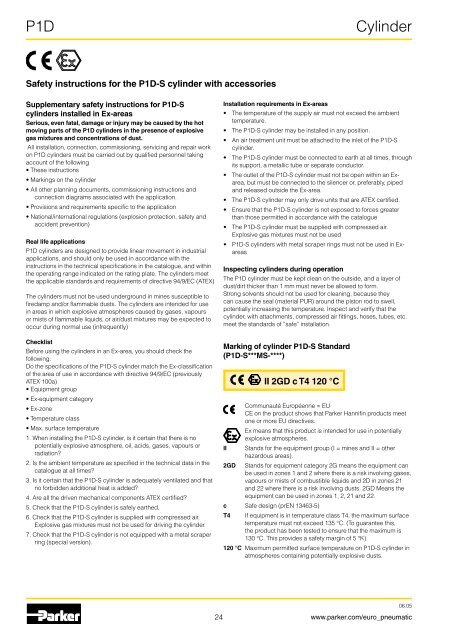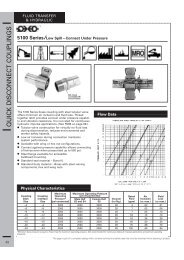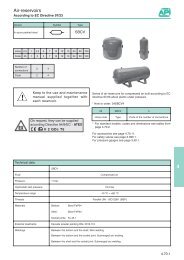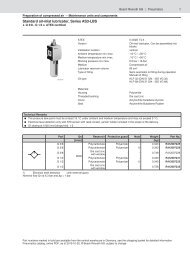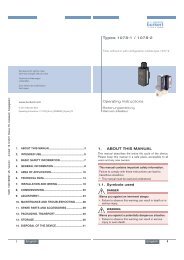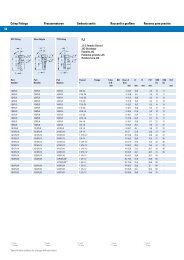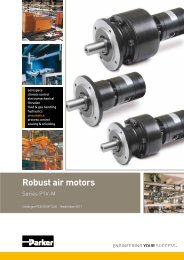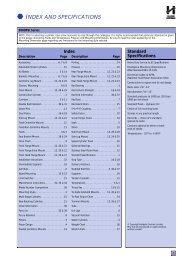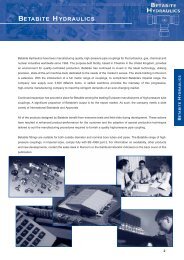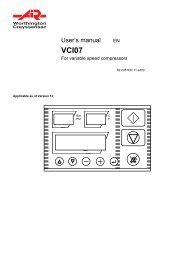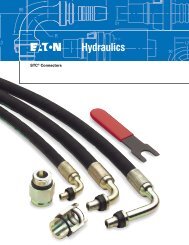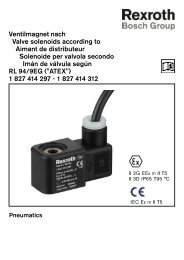Pneumatic cylinders - Duncan Rogers
Pneumatic cylinders - Duncan Rogers
Pneumatic cylinders - Duncan Rogers
- No tags were found...
Create successful ePaper yourself
Turn your PDF publications into a flip-book with our unique Google optimized e-Paper software.
P1DCylinderSafety instructions for the P1D-S cylinder with accessoriesSupplementary safety instructions for P1D-S<strong>cylinders</strong> installed in Ex-areasSerious, even fatal, damage or injury may be caused by the hotmoving parts of the P1D <strong>cylinders</strong> in the presence of explosivegas mixtures and concentrations of dust.All installation, connection, commissioning, servicing and repair workon P1D <strong>cylinders</strong> must be carried out by qualified personnel takingaccount of the following• These instructions• Markings on the cylinder• All other planning documents, commissioning instructions andconnection diagrams associated with the application.• Provisions and requirements specific to the application• National/international regulations (explosion protection, safety andaccident prevention)Real life applicationsP1D <strong>cylinders</strong> are designed to provide linear movement in industrialapplications, and should only be used in accordance with theinstructions in the technical specifications in the catalogue, and withinthe operating range indicated on the rating plate. The <strong>cylinders</strong> meetthe applicable standards and requirements of directive 94/9/EC (ATEX)The <strong>cylinders</strong> must not be used underground in mines susceptible tofiredamp and/or flammable dusts. The <strong>cylinders</strong> are intended for usein areas in which explosive atmospheres caused by gases, vapoursor mists of flammable liquids, or air/dust mixtures may be expected tooccur during normal use (infrequently)ChecklistBefore using the <strong>cylinders</strong> in an Ex-area, you should check thefollowing:Do the specifications of the P1D-S cylinder match the Ex-classificationof the area of use in accordance with directive 94/9/EC (previouslyATEX 100a)• Equipment group• Ex-equipment category• Ex-zone• Temperature class• Max. surface temperature1. When installing the P1D-S cylinder, is it certain that there is nopotentially explosive atmosphere, oil, acids, gases, vapours orradiation?2. Is the ambient temperature as specified in the technical data in thecatalogue at all times?3. Is it certain that the P1D-S cylinder is adequately ventilated and thatno forbidden additional heat is added?4. Are all the driven mechanical components ATEX certified?5. Check that the P1D-S cylinder is safely earthed.6. Check that the P1D-S cylinder is supplied with compressed air.Explosive gas mixtures must not be used for driving the cylinder.7. Check that the P1D-S cylinder is not equipped with a metal scraperring (special version).Installation requirements in Ex-areas• The temperature of the supply air must not exceed the ambienttemperature.• The P1D-S cylinder may be installed in any position.• An air treatment unit must be attached to the inlet of the P1D-Scylinder.• The P1D-S cylinder must be connected to earth at all times, throughits support, a metallic tube or separate conductor.• The outlet of the P1D-S cylinder must not be open within an Exarea,but must be connected to the silencer or, preferably, pipedand released outside the Ex-area.• The P1D-S cylinder may only drive units that are ATEX certified.• Ensure that the P1D-S cylinder is not exposed to forces greaterthan those permitted in accordance with the catalogue• The P1D-S cylinder must be supplied with compressed air.Explosive gas mixtures must not be used• P1D-S <strong>cylinders</strong> with metal scraper rings must not be used in ExareasInspecting <strong>cylinders</strong> during operationThe P1D cylinder must be kept clean on the outside, and a layer ofdust/dirt thicker than 1 mm must never be allowed to form.Strong solvents should not be used for cleaning, because theycan cause the seal (material PUR) around the piston rod to swell,potentially increasing the temperature. Inspect and verify that thecylinder, with attachments, compressed air fittings, hoses, tubes, etc.meet the standards of ”safe” installation.Marking of cylinder P1D-S Standard(P1D-S***MS-****)II2GDCommunauté Européenne = EUCE on the product shows that Parker Hannifin products meetone or more EU directives.Ex means that this product is intended for use in potentiallyexplosive atmospheres.Stands for the equipment group (I = mines and II = otherhazardous areas).Stands for equipment category 2G means the equipment canbe used in zones 1 and 2 where there is a risk involving gases,vapours or mists of combustible liquids and 2D in zones 21and 22 where there is a risk involving dusts. 2GD Means theequipment can be used in zones 1, 2, 21 and 22.c Safe design (prEN 13463-5)T4II 2GD c T4 120 °CIf equipment is in temperature class T4, the maximum surfacetemperature must not exceed 135 °C. (To guarantee this,the product has been tested to ensure that the maximum is130 °C. This provides a safety margin of 5 °K).120 °C Maximum permitted surface temperature on P1D-S cylinder inatmospheres containing potentially explosive dusts.06.0524www.parker.com/euro_pneumatic


